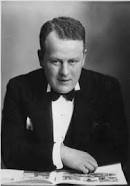After the armistice, social change was inevitable. Trade Unions campaigned for worker's rights and the General Strike in 1927 pushed the British Government to improve the lives of ordinary working people. At the same time, social change brought more leisure time and a boom in the music industry.
Enter Jack Hylton, English pianist, composer, band leader and impresario.
Hylton rose to prominence during the British dance band era, being referred as the "British King of Jazz" and "The Ambassador of British Dance Music" by the musical press, not only because of his popularity which extended throughout the world, but also for his use of unusually large ensembles for the time and his polished arrangements.

Jack’s Early Life:
Jack was born John Greenhalgh Hilton in Bolton on 2nd July 1892. He started by providing piano accompaniment for his father touring clubs, and later had his own act as the “Singing Mill Boy”. He worked as a relief pianist for various bands before joining the Queens Dance Orchestra. Here he arranged and recorded popular songs ‘Directed by Jack Hylton’ and went on to create his own band.Jack Hylton and his Orchestra 1920’s – 1940’s:
In 1923, he started recording under his own name and was so popular, he had to provide surrogate bands for simultaneous performances. These performances would include variety acts and soloists. His band toured America and Europe and he was one of the directors of the Decca record label. The band disbanded in the early 1940’s when many members were being called up for war service.
Jack Hylton is the reason that my family came to live here in Blackpool. My paternal grandfather, Fred Robinson played tenor saxophone in Jack Hylton's band and my father played many of his records when I was growing up. Dad also played Jack's tunes on the family piano. My favorite was The Wedding of The Painted Doll, a song that he taught me to sing. It was the love of this style of music that led me to become a dancer. You can link to the Hylton version of the tune here;
https://www.youtube.com/watch?v=rv9bSRbuXUU
The Wedding of the painted Doll was used in the 1929 Hollywood musical The Broadway Melody. Hollywood actresses were super sophisticated and gloriously glamourous. The 1920s and 30s were a time of revelry, a celebration of peacetime and an era of excess. The music of that period is timeless. There are many young people who now embrace vintage fashion and enjoy dancing to the music of that era. There are web sites and facebook pages dedicated to the Big Bands including The Golden Age of British Dance Bands https://www.facebook.com/groups/282519584859/?fref=nf. I have spent many a happy hour trawling through the photos posted on this site.
As for my grandfather - he met my grandmother Polly while he was performing with Jack Hylton's band at Blackpool Tower Ballroom. Eventually, when they had five children and Polly decided that he had to stay here and not keep touring with the band who had international acclaim. Fred continued to play in the resident bands at The Tower and The Winter Gardens and taught music at home.
There is a museum dedicated to Jack Hylton at the Lancaster University campus that is well worth a visit. Unfortunately I haven't been inspired to write a 'doll' poem this week but I hope that you have enjoyed this blast from the past.
Thanks for reading. Adele Email ThisBlogThis!Share to TwitterShare to Facebook
Reactions:
